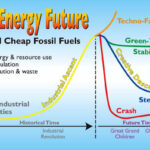What everybody ought to know about Energy
 If you’ve ever looked for an iron-clad case that the fossil energy supply is out-of-control, over-the-top destructive –of planet, wildlife, people’s health and culture– then check out Energy, the latest publication of the Post Carbon Institute.
If you’ve ever looked for an iron-clad case that the fossil energy supply is out-of-control, over-the-top destructive –of planet, wildlife, people’s health and culture– then check out Energy, the latest publication of the Post Carbon Institute.
The word “breathtaking” has become cliche when put with “photographs” but here it really applies. You will gasp aloud as you turn each page. (even my teens did) And then you’ll want to show the pictures to more people, because you can’t keep this kind of stuff to yourself. Coal strip mines. Spawling oil fields. Landscape wracked by palm oil plantations. The debris of Fukushima. And of course the BP oil platform going down in flames.
The photos do such a good job of drawing you in that it is hard to get to the text. Maybe that’s why Post Carbon Institute simultaneously released a paperback — theEnergy reader version — which apparently skips the photos. Unlike many coffee-table books, in Energy the text is astounding. Post Carbon Institute has assembled an all-star list of contributors, including Richard Heinberg, James Hanson, Wendell Berry, John Michael Greer, and Bill McKibben.
It’s a monster of a book — at 14″ x 12″, it’s so much book that it makes me feel guilty about the energy required to make and ship it — that reveals in shocking horror the devastation behind our conventional sources of energy. Oil, gas, coal, nuclear, Energy covers them all. It debunks “clean coal,” and “Drill Baby Drill.” There are many sections devoted to fracking, which is described as “a bridge fuel to nowhere.”
Unconventional energy supplies are covered too, with a note on each one that reveals that energy source’s “Key Limiting Factor” (where it falls short, for example Low Net Energy Ratio, heavy water user, etc.). There are solid explanations of EROEI and Embodied Energy, and there’s the constant presence of the concepts of peak oil. Energy doesn’t dodge the population discussion, and it includes plenty on climate change.
It is quite light on the ideas of Reduce, deep cuts to consumerism, unshopping, and the realities of what powerdown is going to look like (but perhaps they thought they’d better stop at 273 pages and leave those to someone else). And it’s very weak on economics. Like all Heinberg books, Energy is heavy on awareness-raising and talking about The Problem, and far too light on what we can do about it.
What’s it good for?
All these staggering images, coupled with the pounding text, create a pretty grim book. (maybe it should be packaged together with the joyful and colorful Transition Companion) The question arises: who were they writing for and what do you do with the thing?
Energy makes a pretty rugged package for under the Christmas tree, even though admittedly that’s why I bought it. Environmentalists know a lot of this stuff already, so they don’t “need” the book (although some will probably yearn to own it). The people you want to have read this book are those who are promoting the fossil energy nightmare — and good luck getting them to sit down with it.
In a dream world, it might be fun to get a crowd-funded campaign going, to get a copy of Energy placed in every public library, every high school, every congressman’s office. Those are the kind of places that need this book. So if you’re curious about Energy, might I suggest just that:
- Buy a copy, the full-color version. Read it, show it around to your friends. And then donate it to the library at your nearest high school.
Energy is far too big, physically, to be tucked away on a shelf. It will have to sit out on a counter someplace. And then people will see it. And open the cover. And the secrets of Energy will be revealed.

